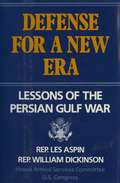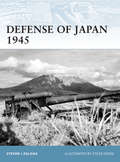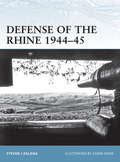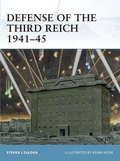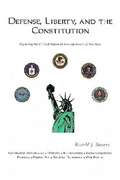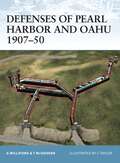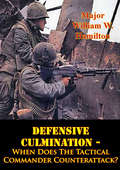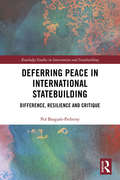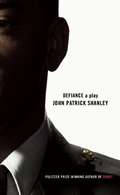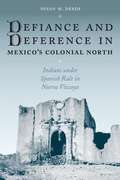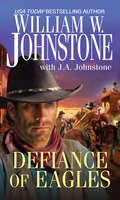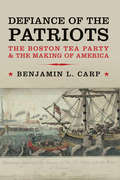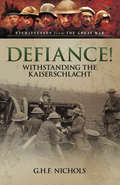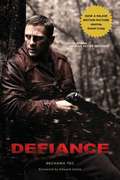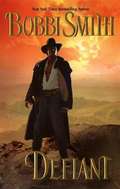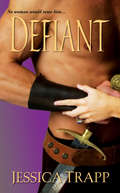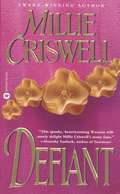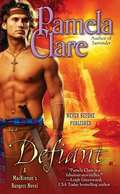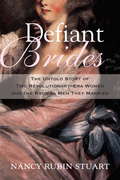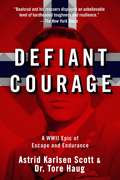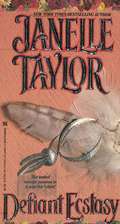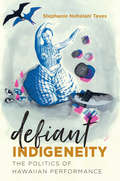- Table View
- List View
Defense for a New Era: Lessons Of The Persian Gulf War (Association Of The U. S. Army Book Ser.)
by Les Aspin William Dickinson"This bipartisan study, coauthored by Aspin, the Democratic chairman of the House Armed Services Committee, and Dickinson, its ranking Republican member, aims to teach Congress the lessons of the Gulf war with a view toward future defense policy and budgeting."—Publishers Weekly
Defense of Japan 1945
by Steven Zaloga Steve NoonIn 1945, with her fleet destroyed and her armies beaten, the only thing that stood between Japan and an Allied invasion was the numerous coastal defence positions that surrounded the islands. This is the first book to take a detailed look at the Japanese home island fortifications that were constructed during 1941-45. Utilizing diagrams, specially commissioned artwork, and sources previously unavailable in English, Steven Zaloga examines these defences in the context of a possible Allied invasion, constructing various arguments for one of the greatest 'what if' scenarios of World War II, and helping to explain why the Americans decided to go ahead with a nuclear option.From the Trade Paperback edition.
Defense of the Rhine 1944-45
by Steven Zaloga Adam HookThe Rhine River represented the last natural defensive barrier for the Third Reich in the fall of 1944. Although Hitler had been reluctant to allow the construction of tactical defense lines in France, the final defense of the Reich was another matter. As a result, construction of a Rhine defense line began in September 1944. Steven J Zaloga examines the multiple phases of construction undertaken to strengthen the Westwall (Siegfried Line), to fortify many of the border villages, and finally to prepare for the demolition of the Rhine bridges. Using detailed maps, color artwork, and expert analysis, this book takes a detailed look at Germany's last line of defense.
Defense of the Third Reich 1941-45
by Steven Zaloga Adam HookDuring World War II Germany was subjected to the growing threat of Allied bomber attack, from RAF night bombing to American daylight bombing. From flak artillery to fortified structures, this book focuses on the land-based infrastructure of Germany's defense against the air onslaught.The Third Reich created the most lavish Flak defenses of any country in World War II. This book provides an overview of the Flak artillery, with a special emphasis on how Flak was deployed and some of the unique fortified structures that were created to enhance Flak performance such as the legendary Flak towers of the German cities. It also briefly examines the revolutionary potential of anti-aircraft missiles for Flak defense that were on the verge of deployment at the end of the war. Although the artillery element of Flak is the most widely known, Flak effectiveness was highly dependent on advanced electronic sensors, especially radar, for fire control and precise targeting. This book examines how the Third Reich deployed radar and other advanced sensors in its defensive belts such as the Kammhuber Line.Besides active defense against air attack, Germany also invested heavily in passive defense such as air raid shelters. While much of this defense was conventional such as underground shelters and the dual use of subways and other structures, Germany faced some unique dilemmas in protecting cities against night fire bomb raids. Some cities were located in regions where the soil conditions and lack of bedrock did not permit deep underground bunkers. As a result, German architects designed massive above-ground defense shelters which were amongst the most massive defensive structures built in World War II. The success of the US Army Air Force offensive against Germany industry in early 1944 threatened to crush German military production. A program was initiated in the spring of 1944 to defend the industry by dispersion and fortification. An elaborate program was created to house the most vital industries in underground shelters. Some of these were located in caves or tunnels, but in other areas, large reinforced concrete structures were created where caves were not a practical solution. These structures were amongst the most advanced for their day, and in many ways presaged the heavily reinforced shelters created during the Cold War for protection against nuclear attack.From the Trade Paperback edition.
Defense, Liberty, and the U.S. Constitution: Exploring the Critical National Security Issues of Our Time
by Ron SievertEach chapter in this work was written with an intent to identify in advance and thoroughly discuss many of the important legal issues that are likely to emerge as a result of today's national security threats. It is the author's hope that this work will encourage solutions before it is too late to proceed with deliberation and logic, such as has been the case in too many previous incidents.
Defenses of Pearl Harbor and Oahu 1907-50
by Chris Taylor Glen WillifordAt the beginning of the 20th century, the military importance of the Hawaiian Islands became clear. Oahu in particular was a key bastion in projecting America's military power in the Pacific. The island was turned into a military fortress - and yet it also became the site of one of America's greatest defensive failures, the Japanese attack of December 7, 1941. By the end of World War II, the harbor itself was the most heavily defended in the world, and the island had earned the sobriquet "Fortress Oahu". This title documents the development of the coastal, air and land defense systems that served to protect Pearl Harbor and Honolulu from 1907 to 1950, and seeks to understand why these failed at a critical point.
Defensive Culmination - When Does The Tactical Commander Counterattack?
by Major William W. HamiltonOne of German General Carl Von Clausewitz's key concepts is culmination. His primary work On War describes culmination for the attacker as the point beyond which he can no longer continue his attack and risks destruction from a counterattack. For the defender it is the point beyond which the defender gains no more advantages by continuing his defense. At this point the defender must decide to act. Clausewitz envisioned that at this point the defender would release his flashing sword of vengeance and counterattack. Clausewitz developed the concept of culmination for what we regard today as the strategic and operational levels of war. This paper seeks to answer the question, Does the concept of defensive culmination apply at the tactical level and can the tactical defender use it to determine when to counterattack?This paper uses three historical examples to examine when and how commanders executed tactical counterattacks. The examples are used to evaluate a theoretical framework of Clausewitz's defensive concepts. The criteria used to evaluate the historical cases are: defensive preparation, terrain, availability of intelligence on the attacker, timing for the defender and attacker, determination of the defender's defeat mechanism, depth of the defense, type of counterattack, the timing of the counterattack, and condition of the attacker and defender when the counterattack was executed. The key concepts examined are culmination and counterattack timing.
Deferring Peace in International Statebuilding: Difference, Resilience and Critique (Routledge Studies in Intervention and Statebuilding)
by Pol Bargués-PedrenyThis book explores the last 25 years of international peacebuilding and recasts them as a growing crisis of confidence in universal ideas of peacebuilding and self-government. Since current peacebuilding interventions are abandoning domineering, top-down and linear methodologies, and experimenting with context-sensitive, self-reflexive and locally driven strategies, the book makes two suggestions. The first is that international policymakers are embracing some of the critiques of liberal peace. For more than a decade, scholarly critiques have pointed out the need to focus on everyday dynamics and local initiatives and resistances to liberal peace in order to enable hybrid and long-term practice-based strategies of peacebuilding. Now, the distance between the policy discourse and critical frameworks has narrowed. The second suggestion is that in stepping away from liberal peace, a transvaluation of peacebuilding values is occurring. Critiques are beginning to accept and valorise that international interventions will continuously fail to produce sensitive results. The earlier frustrations with unexpected setbacks, errors or contingencies are ebbing away. Instead, critiques normalise the failure to promote stability and peace. This book will be of much interest to students of peacebuilding, international intervention, conflict resolution, international organisations and security studies in general.
Defiance
by John Patrick Shanley"Defiance is a necessary step in the life of an individual and in the life of a nation."--John Patrick Shanley"As thoughtful and probing as its predecessor, Defiance [is] filled with the provocative questions and bristling dialogue for which Mr. Shanley is known . . . as it wonders about its big, knotty subjects."--Ben Brantley, The New York Times Defiance is the "very rich and satisfying" (The Village Voice) second work in John Patrick Shanley's trilogy that began with Doubt. The play is set in 1971 at Camp Lejeune, North Carolina, where Lt. Col. Morgan Littlefield and his reluctant protégé Capt. Lee King--a young African American officer--clash over issues of race and authority within the Marine Corps, even as the civil rights movement and Vietnam War divide the world outside. In this high-stakes struggle at the top of the ranks, witnessed by the base's inquisitive Chaplain White and Littlefield's irreproachable wife Margaret, Shanley has crafted another timely play exploring issues of power and morality within a hallowed institution. John Patrick Shanley's Doubt won the 2005 Pulitzer Prize for Drama and the Tony Award for Best Play, and was chosen as best play of the year by over ten news-papers and magazines. His other plays include Danny and the Deep Blue Sea, Four Dogs and a Bone, Psychopathia Sexualis, and Savage Limbo. He has written extensively for TV and film, including Moonstruck, for which he won an Academy Award for best screenplay.
Defiance and Deference in Mexico's Colonial North: Indians under Spanish Rule in Nueva Vizcaya
by Susan M. DeedsIn their efforts to impose colonial rule on Nueva Vizcaya from the sixteenth century to the middle of the seventeenth, Spaniards established missions among the principal Indian groups of present-day eastern Sinaloa, northern Durango, and southern Chihuahua, Mexico—the Xiximes, Acaxees, Conchos, Tepehuanes, and Tarahumaras. Yet, when the colonial era ended two centuries later, only the Tepehuanes and Tarahumaras remained as distinct peoples, the other groups having disappeared or blended into the emerging mestizo culture of the northern frontier. Why were these two indigenous peoples able to maintain their group identity under conditions of conquest, while the others could not? In this book, Susan Deeds constructs authoritative ethnohistories of the Xiximes, Acaxees, Conchos, Tepehuanes, and Tarahumaras to explain why only two of the five groups successfully resisted Spanish conquest and colonization. Drawing on extensive research in colonial-era archives, Deeds provides a multifaceted analysis of each group's past from the time the Spaniards first attempted to settle them in missions up to the middle of the eighteenth century, when secular pressures had wrought momentous changes. Her masterful explanations of how ethnic identities, subsistence patterns, cultural beliefs, and gender relations were forged and changed over time on Mexico's northern frontier offer important new ways of understanding the struggle between resistance and adaptation in which Mexico's indigenous peoples are still engaged, five centuries after the "Spanish Conquest."
Defiance of Eagles (Eagles #18)
by William W. Johnstone J.A. JohnstoneThe MacCallister clan saddles up against a legendary outlaw gang in this hard-charging adventure from the greatest Western writer of the 21st century.Even the battleground—by defying the odds . . . Boyd Ackerman is no ordinary criminal. Trained by the U.S. Army, commanding his band of killers with military efficiency, Ackerman has outsmarted and outfought every lawman who has tried to stop him. But he&’s never faced a MacCallister before . . . Falcon MacCallister isn&’t looking for a fight. Then Ackerman&’s Raiders kill his niece&’s husband—and take the young woman hostage. Falcon and his brothers ride into action. With three transplanted sons of the Scottish Highlands attacking an army of steely-eyed, battle-hardened killers, a small Montana town will bear witness to the bloodiest and most hellish gun battle in the history of the frontier . . . Praise for the Eagles series &“[A] rousing, two-fisted saga of the growing American frontier.&”—Publishers Weekly &“Solid, page-turning entertainment featuring a larger-than-life, old-fashioned hero in MacCallister.&”—Booklist
Defiance of the Patriots
by Benjamin L. CarpOn the evening of December 16, 1773, a group of disguised Bostonians boarded three merchant ships and dumped more than forty-six tons of tea into Boston Harbor. The Boston Tea Party, as it later came to be known, was an audacious and revolutionary act. It set the stage for war and cemented certain values in the American psyche that many still cherish today. But why did the Tea Party happen? Whom did it involve? What did it mean? The answers to these questions are far from straightforward. In this thrilling new book, Benjamin L. Carp tells the full story of the Tea Party--exploding myths, exploring the unique city life of Boston, and setting this extraordinary event in a global context for the first time. Bringing vividly to life the diverse array of people and places that the Tea Party brought together--from Chinese tea-pickers to English businessmen, Native American tribes, sugar plantation slaves, and Boston's ladies of leisure--Carp illuminates how a determined group shook the foundations of a mighty empire, and what this has meant for Americans since. As he reveals many little-known historical facts and considers the Tea Party's uncertain legacy, he presents a compelling and expansive history of an iconic event in America's tempestuous past.
Defiance!: Withstanding the Kaiserschlacht (Eyewitnesses from The Great War)
by G.H.F. NicholsGeorge Nichols was an artillery officer serving with the 82nd Brigade, Royal Field Artillery. He was wounded in 1917, and returned to the guns in March 1918, just in time to experience the fury of the Kaiserschlacht, the great German offensive designed to knock the British army out of the war.Nichols wrote a powerful account of the Kaiser's last great offensive battle from inside the eye of the storm, and it is one of the few primary source accounts which are told from the often overlooked perspective of the British artillerymen. Nichols, with wonderful British reserve, records how the men of the Royal Field Artillery steadfastly manned their guns. Nichols survived the onslaught and in 1919, was able to produce a full account of both the retreat and the British counter-attack which won back the lost ground.First published in 1919, while censorship was still in force, this wonderful primary source has long been out of print and it's welcome return makes for essential reading for anyone with an interest in the Great War.
Defiance: The Bielski Partisans
by Nechama TecThe prevailing image of European Jews during the Holocaust is one of helpless victims, but in fact many Jews struggled against the terrors of the Third Reich. In Defiance, Nechama Tec offers a riveting history of one such group, a forest community in western Belorussia that would number more than 1,200 Jews by 1944--the largest armed rescue operation of Jews by Jews in World War II. Tec reveals that this extraordinary community included both men and women, some with weapons, but mostly unarmed, ranging from infants to the elderly. She reconstructs for the first time the amazing details of how these partisans and their families--hungry, exposed to the harsh winter weather--managed not only to survive, but to offer protection to all Jewish fugitives who could find their way to them. Arguing that this success would have been unthinkable without the vision of one man, Tec offers penetrating insight into the group's commander, Tuvia Bielski. Tec brings to light the untold story of Bielski's struggle as a partisan who lost his parents, wife, and two brothers to the Nazis, yet never wavered in his conviction that it was more important to save one Jew than to kill twenty Germans. She shows how, under Bielski's guidance, the partisans smuggled Jews out of heavily guarded ghettos, scouted the roads for fugitives, and led retaliatory raids against Belorussian peasants who collaborated with the Nazis. Herself a Holocaust survivor, Nechama Tec here draws on wide-ranging research and never before published interviews with surviving partisans--including Tuvia Bielski himself--to reconstruct here the poignant and unforgettable story of those who chose to fight.
Defiant
by Bobbi SmithClint goes undercover as a gun fighter to track down the gang that killed his family and left him for dead. While in pursuit of the gang he repeatedly rescues Rachel from danger and falls in love with her.
Defiant
by Jessica TrappShe Forced His HandThree years ago Jared St. John was imprisoned, wrongly, for the murder of his own brother. Now, finally free, he wishes only to live in peace, hoping to heal the darkness that plagues his soul. But his self-inflicted isolation is destroyed when he is drugged, spirited away to a church, and forced to marry a brazen enchantress against his will. . . He Captured Her HeartLady Gwyneth of Windrose knows something of false imprisonment, but that doesn't stop her from abducting a stranger when it's her only hope of gaining her liberty. Yet the moment she's alone in her unwilling new husband's powerful presence, everything Gwyneth thought she knew of men--and of seduction--falls by the wayside. For the first time in her life, it's not freedom Gwyneth craves. . .but to give herself over to unyielding passion. . . "This highly sensual battle of wills/captive-captor romance is highly reminiscent of early Johanna Lindsey." --Romantic Times on Pleasures of Sin "Jessica Trapp mixes passion, betrayal, abduction and revenge into a tasty brew." --Hannah Howell on Master of Pleasure
Defiant
by Millie CriswellAttorney Travis Bodine faces the toughest challenge of his career defending his brother Rafe against murder charges. To make matters worse he has to work with his ex-fiancee, Hannah. The two must put the past behind them to save Rafe's life.
Defiant
by Pamela ClareCharged with a crime they didn't commit, the MacKinnon brothers faced a death sentence until they agreed to serve the British Crown in the colonies and take up arms against the French. Allied with the Indian tribes who lived beside them in the wilderness, the Scottish Highland warriors forged a new breed of soldier... MacKinnon's Rangers Major Connor MacKinnon despises his commander, Lord William Wentworth, beyond all other men. Ordered to rescue Wentworth's niece after the Shawnee take her captive, he expects Lady Sarah Woodville to be every bit as contemptible as her uncle. Instead, he finds a brave and beautiful lass in desperate peril. But the only way to free Sarah is for Connor to defeat the Shawnee warrior who kidnapped her--and claim her himself. Torn by tragedy from her sheltered life in London, Lady Sarah is unprepared for the harshness of the frontier--or for the attraction she feels toward Connor. When they reach civilization, however, it is she who must protect him. For if her uncle knew all that Connor had done to save her, he would surely kill him. But the flames of passion, once kindled, are difficult to deny. As desire transforms into love, Connor will have to defy an empire to keep Sarah at his side.
Defiant
by Patricia PotterOnly the desire for vengeance had spurred Wade Foster on, until the last of the men who had destroyed his family lay sprawled in the dirt. Now, badly wounded, the rugged outlaw closed his eyes against the pain ... and awoke to a tender touch. He'd never asked Mary Jo Williams to save him; couldn't understand why a lawman's widow hadn't the sense to leave a stranger to his fate. But the daring beauty refused to abandon him. And soon, when a posse gets too close and danger rushes in, Wade will have to choose between fleeing and risking everything for this dauntless woman who could show him how to live-and love-again. ...
Defiant Brides
by Nancy Rubin StuartThe story of two Revolutionary-era teenagers who defy their Loyalist families to marry radical patriots, Henry Knox and Benedict Arnold, and are forever changed When Peggy Shippen, the celebrated blonde belle of Philadelphia, married American military hero Benedict Arnold in 1779, she anticipated a life of fame and fortune, but financial debts and political intrigues prompted her to conspire with her treasonous husband against George Washington and the American Revolution. In spite of her commendable efforts to rehabilitate her husband's name, Peggy Shippen continues to be remembered as a traitor bride. Peggy's patriotic counterpart was Lucy Flucker, the spirited and voluptuous brunette, who in 1774 defied her wealthy Tory parents by marrying a poor Boston bookbinder simply for love. When her husband, Henry Knox, later became a famous general in the American Revolutionary War, Lucy faithfully followed him through Washington's army camps where she birthed and lost babies, befriended Martha Washington, was praised for her social skills, and secured her legacy as an admired patriot wife. And yet, as esteemed biographer Nancy Rubin Stuart reveals, a closer look at the lives of both spirited women reveals that neither was simply a "traitor" or "patriot." In Defiant Brides, the first dual biography of both Peggy Shippen Arnold and Lucy Flucker Knox, Stuart has crafted a rich portrait of two rebellious women who defied expectations and struggled--publicly and privately--in a volatile political moment in early America. Drawing from never-before-published correspondence, Stuart traces the evolution of these women from passionate teenage brides to mature matrons, bringing both women from the sidelines of history to its vital center. Readers will be enthralled by Stuart's dramatic account of the epic lives of these defiant brides, which begin with romance, are complicated by politics, and involve spies, disappointments, heroic deeds, tragedies, and personal triumphs.
Defiant Courage: A WWII Epic of Escape and Endurance
by Astrid Karlsen Scott Tore Haug Harald ZwartThe incredible true story of one man's escape from Nazis in Norway."I remember reading We Die Alone in 1970 and I could never forget it. Then when we went to Norway to do a docudrama, people told us again and again that certain parts were pure fiction. Since I was a Norwegian that was not good enough; I had to find the truth. I sincerely believe we did," writes author Astrid Karlsen Scott. Defiant Courage is the true story of what Jan Baalsrud endured as he tried to escape from the Gestapo in Norway's Troms District.In late March 1943, in the midst of WWII, four Norwegian saboteurs arrived in northern Norway on a fishing cutter and set anchor in Toftefjord to establish a base for their operations. However, they were betrayed, and a German boat attacked the cutter, creating a battlefield and spiraling Jan Baalsrud into the adventure of his life. The only survivor, a wounded Baalsrud begins a perilous journey to freedom, swimming icy fjords, climbing snow-covered peaks, enduring snowstorms, and getting caught in a monstrous avalanche. More than sixty people of the Troms District risk their lives to help Baalsrud, suffering from snow blindness and frostbite, to freedom. Meticulously researched for more than five years, Karlsen Scott and Haug bring forth the truth behind this captivating, edge-of-your-seat, real-life survival story.
Defiant Ecstasy (Gray Eagle Series #2)
by Janelle TaylorAn imprisoned Englishwoman awaits to be rescued by a sexy Sioux warrior in this romance novel by the New York Times–bestselling author of Savage Ecstasy.The longer Alisha Williams remained at Fort Pierre, the more she hoped her lover would rescue her from the taunts and tirades of the white pioneers. They would never let her forget she had been the mistress of the infamous fierce warrior, Gray Eagle. As if the auburn-haired beauty could forget! Each night, Alisha sweetly remembered Gray Eagle&’s bold caresses, burning kisses, his blazing passion. Each day, she scanned the vast horizon in hopes her Oglala brave would recapture her. Then one day, Alisha saw hundreds of Indian warriors riding to the gates of Fort Pierre—and at their head was the fierce Gray Eagle. Though her most fervent prayers had been answered, Alisha&’s heart skipped a beat: Would Gray Eagle destroy her—or make her destiny his own?Praise for Defiant Ecstasy&“I thought Taylor&’s ability to keep the conflict, action and mystery going into this second book was brilliant. And very difficult to do . . . An adventure you will not want to miss . . . This is a compelling story I could not put down.&” —Regan Walker, author of The Donet Trilogy
Defiant Heart (Westward Hearts)
by Tracey BatemanIn Book One of the Westward Hearts series, orphans Fannie Caldwell and her two young siblings have spent the last three years as indentured servants under a cruel master. Desperately wanting a better life for her brother and sister, Fannie devises a plan to secretly join a wagon train heading west. Her plan immediately runs into trouble when the handsome yet bullheaded wagon master Blake Tanner refuses to allow an unmarried woman on the train. But Fannie's determined—she'll escape and go west with or without help. As life on the trail tests everyone's endurance and faith, Fannie soon realizes the perils of being a single woman on the frontier. Witnessing Fannie fending off one scare after another, Blake slowly recognizes how much he cares for this alluring young woman. Will Blake sacrifice his own dreams and guide Fannie to safety? Or will Fannie's stubborn independence keep her from finding true love?
Defiant Hearts
by Janelle TaylorAs the Civil War divides a nation, a man and a woman--enemies and lovers who can neither trust nor resist each other--seek their destiny in the shadow of passion, treachery and betrayal.
Defiant Indigeneity: The Politics of Hawaiian Performance (Critical Indigeneities)
by Stephanie Nohelani Teves"Aloha" is at once the most significant and the most misunderstood word in the Indigenous Hawaiian lexicon. For K&257;naka Maoli people, the concept of "aloha" is a representation and articulation of their identity, despite its misappropriation and commandeering by non-Native audiences in the form of things like the "hula girl" of popular culture. Considering the way aloha is embodied, performed, and interpreted in Native Hawaiian literature, music, plays, dance, drag performance, and even ghost tours from the twentieth century to the present, Stephanie Nohelani Teves shows that misunderstanding of the concept by non-Native audiences has not prevented the K&257;naka Maoli from using it to create and empower community and articulate its distinct Indigenous meaning.While Native Hawaiian artists, activists, scholars, and other performers have labored to educate diverse publics about the complexity of Indigenous Hawaiian identity, ongoing acts of violence against Indigenous communities have undermined these efforts. In this multidisciplinary work, Teves argues that Indigenous peoples must continue to embrace the performance of their identities in the face of this violence in order to challenge settler-colonialism and its efforts to contain and commodify Hawaiian Indigeneity.
